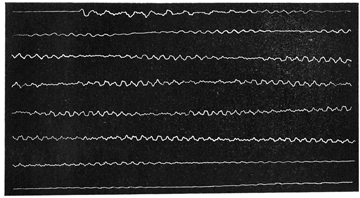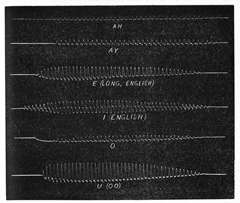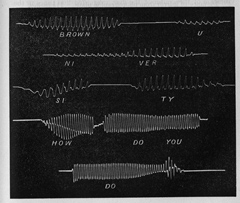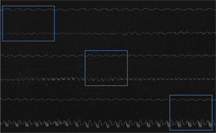 |
Optical Sound Track MethodNOTE: This initial account of methods for transducing images into sound—first posted in 2009—is maintained here for its historical interest. You can also find it archived in Archive.org's Wayback Machine. For current information, please visit griffonage.com. |
[<< Part 1]
2. Wavy Lines2.1—We can also use ImageToSound to play oscillographic inscriptions that take the form of wavy lines, such as phonautograms or gramophone discs. The program isn't really designed to do this, so it takes a bit more processing work. I take a waveform like the one at the top of the illustration below and create two images from it, one with the area above the waveform filled in white, the other with the area below the waveform filled in white. These two images are bands of varying width that ImageToSound can play.
I run both images through ImageToSound, put the resulting WAV files into the two channels of a stereo file, reduce the file to mono, and get a sound file with something very close to the "shape" of the original inscription. Optimal results require some additional tricks and steps, but what I've described is the essential part and enough to get you started if you'd like to try this yourself. 2.2—Here's one of my first experiments using this approach, a plate from Edward Wheeler Scripture's Researches in Experimental Phonetics (1906), apparently traced mechanically from an unspecified Berliner gramophone disc:
It sounds like a gong when educed, albeit with a noticeable pitch wobble that presumably has something to do with a flaw in Scripture's setup: . |
 |
2.3—In the summer of 1878, Eli Whitney Blake, Jr., of Brown University published several inscriptions of speech sounds he had recorded photographically. The first two images below are from Silliman's American Journal of Science and Arts, and the others are from Nature.
This was one of my early experiments, and I hope to get around to redoing it soon to take advantage of improved techniques. But here's a preliminary eduction of the above plates, in the order shown, with speeds as indicated by Blake (except 20 ips where he indicates 40 ips, an apparent typo on his part): . Do you hear "Ah, Ay, E, I, O, U, Brown University, how do you do, Brown University, how do you do"? If so, I believe these are the earliest identifiably recovered sounds of spoken English with a definite provenance. Read more about them here. 2.4—I've also used this technique to educe some phonautograms as part of the First Sounds collaborative. Using only the methods described so far, here's the sound I was able to evoke from two examples originally scanned by David Giovannoni in the archives of the Académie des Sciences: Vole, Petite Abeille (No. 7) and Excerpt from Torquato Tasso's Aminta (No. 8) . Édouard-Léon Scott de Martinville rotated his cylinder by hand at an irregular rate, so the speed varies and wobbles in the two examples above. But during 1860, Scott typically recorded a tuning fork "time code" alongside the trace of the sound he was attempting to study. In the image below, the voice trace is circled in red, the tuning fork trace in blue:
If we make the two traces the two tracks of a stereo file, we get this: Vole, Petite Abeille (No. 7) and Excerpt from Torquato Tasso's Aminta (No. 8) . Scott's tuning fork drew dots instead of a wavy line for much of No. 7, so I educed it using the "rows of dots" method, which is why it sounds a bit like the buzzing of a bee—with apologies to Charlotte Green at the BBC.
Next we adjust the tuning fork trace so that five cycles are always one fiftieth of a second, adjusting the voice track at the same time: Vole, Petite Abeille (No. 7) and Excerpt from Torquato Tasso's Aminta (No. 8) . Finally, we get rid of the tuning fork, leaving us just the voice: That's how it was done! [Part 3 >>] |









